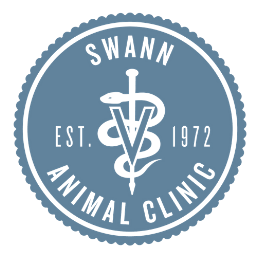Fall is one of my favorite times of the year. I love the color changes, the cooling of the weather, and, of course, the football games! One part of the season that I am NOT a big fan of are the diseases that seem to pop up. Yep – it’s getting close to cold and flu season. While there isn’t such thing as the “canine common cold,” there is something similar. So in honor of the season, I am going to write about Canine Infectious Tracheobronchitis or “Kennel Cough.”
Kennel Cough is an acute infection of the upper respiratory system that is the most common respiratory disease in our canine patients. The term Kennel Cough is actually an umbrella term to cover the many bacteria and viruses that all cause the same clinical symptoms. These include five viruses (distemper, parainfluenza, adenovirus, influenza, and herpesvirus) and three bacteria (Bordetella, Mycoplasma, and Streptococcus). While that may seem like a lot of causes, it’s overall a pretty easy syndrome to deal with and prevent! So let’s first talk about how your dog would get infected with Kennel Cough.
The viruses and bacteria that cause Kennel Cough are transmitted in the respiratory secretions – saliva, mucus, etc – of an infected dog. Your pet must then have their nose or mouth come in contact with the actual secretions or a surface that has had the secretions on it. This is why places that have lots of dogs frequent them (boarding facilities, grooming facilities, dog parks or shelters, pet stores) are the most common places your pet will pick up the disease.
Once your dog becomes infected, the most common clinical signs that you will notice are sneezing, coughing, discharge from the eye and/or nose, and tracheal sensitivity. Many owners think the dog is trying to cough something up because it is common to have retching at the end of the cough – this is just because dogs cannot clear their throat after coughing as we can. In more severe cases, you may see lethargy (loss of energy), anorexia (loss of appetite), or even dyspnea (changes in or difficulty breathing). When you bring your pet in, we will likely ask you some questions about your pet’s vaccination status and whether they have been to places that other dogs go. The reason we ask you these questions is that most of the time Kennel Cough ends up being a presumptive diagnosis. Yes, there are tests that we can run to figure out which virus or bacteria is causing the coughing, but they are expensive and take time. Usually, we will see the clinical signs and match it to the history to come up with our diagnosis (just like your doctor does to diagnose the cold or flu).
Once we diagnose your pet with Kennel Cough, we will talk about treatment. Some dogs with mild cases don’t need treatment. They will eventually clear their cough on their own in about 10 days. Most dogs, however, will benefit from supportive care. This can include some antibiotics, cough suppressants, or nebulization. This will be up to your veterinarian to decide. It is always the best thing to bring your furry loved one in to be seen so that your veterinarian can advise you on the steps to take to make them feel better. The prognosis of Kennel Cough is very good
The best news about this disease is that it is controllable! The yearly vaccination that your dog should get covers distemper, parainfluenza, and adenovirus. There is now a vaccination for influenza. There is also a vaccination for Bordetella (this is the one that is known as the Kennel Cough vaccine). You will probably notice that those vaccinations did not cover every single cause, so even if you vaccinate your dog, they could still get kennel cough. It is much rarer, however. Not every pet needs every one of those vaccinations. When you bring your pet in for their vaccinations, we will discuss their lifestyle and decide which vaccinations they need based on that. Your veterinarian is always the best place to go for advice about your pets.
I hope that you all have a great fall season! Enjoy the weather, the falling leaves, and the tailgates! I will talk to you all next month!!
About the Author
Dr. Heritage Enevoldsen
 Dr. Heritage Enevoldsen was born and raised in Amarillo, Texas. She had always dreamed of finding a job that would allow her to minister to and bless people, but also involve her love for animals, so being a veterinarian was just the right fit! She received her Bachelor of Science from Texas A&M University before graduating from Texas A&M College of Veterinary Medicine in May of 2017. Her goal was always to come back and serve the people of the Texas panhandle. Dr. Enevoldsen has a special interest in dermatology, surgery, and dentistry as well as client education. When she isn’t working at the clinic, Dr. Enevoldsen loves spending time with her son and husband, reading, and anything to do with the Fighting Texas Aggies. She is a dog mom to her pet, Mark, who is the most handsome mutt you have ever seen.
Dr. Heritage Enevoldsen was born and raised in Amarillo, Texas. She had always dreamed of finding a job that would allow her to minister to and bless people, but also involve her love for animals, so being a veterinarian was just the right fit! She received her Bachelor of Science from Texas A&M University before graduating from Texas A&M College of Veterinary Medicine in May of 2017. Her goal was always to come back and serve the people of the Texas panhandle. Dr. Enevoldsen has a special interest in dermatology, surgery, and dentistry as well as client education. When she isn’t working at the clinic, Dr. Enevoldsen loves spending time with her son and husband, reading, and anything to do with the Fighting Texas Aggies. She is a dog mom to her pet, Mark, who is the most handsome mutt you have ever seen.
